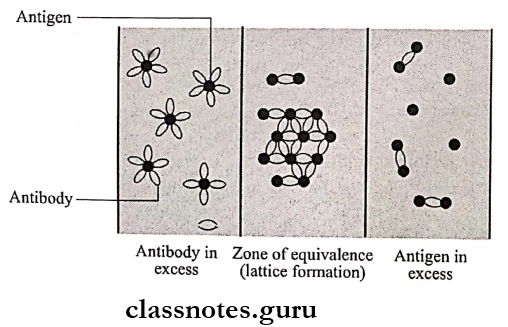Antigen-Antibody Reaction
Question 1. Precipitation reaction.
Answer:
Precipitation Reaction Definition:
- When a soluble antigen reacts with its antibody in the presence of electrolytes at an optimal temperature and pH, the antigen-antibody complex forms an insoluble precipitate.
- This process is called precipitation.
Read And Learn More: Microbiology Question and Answers
Precipitation Reaction Mechanism
- Marrack in 1934 proposed the lattice hypothesis to explain the mechanism of precipitation.
- According to it, multivalent antigens combine with bivalent antibodies.
- Precipitation occurs only when a large lattice is formed.
- This is possible only in the zone of equivalence.
- Zone Of Equivalence.
- Antigen and antibodies are present in optimal proportion.
- Thus, a large lattice is formed and precipitation occurs.
- Zone Of Antigen Excess.
- The valencies of the antibody are fully satisfied.
- Thus lattice is not formed.
- Zone Of Antibody Excess.
- Valencies of the antigen are taken up by antibodies and a lattice is not formed.
- Zone Of Equivalence.
Antigen antibody reaction and its types
Precipitation Reaction Types

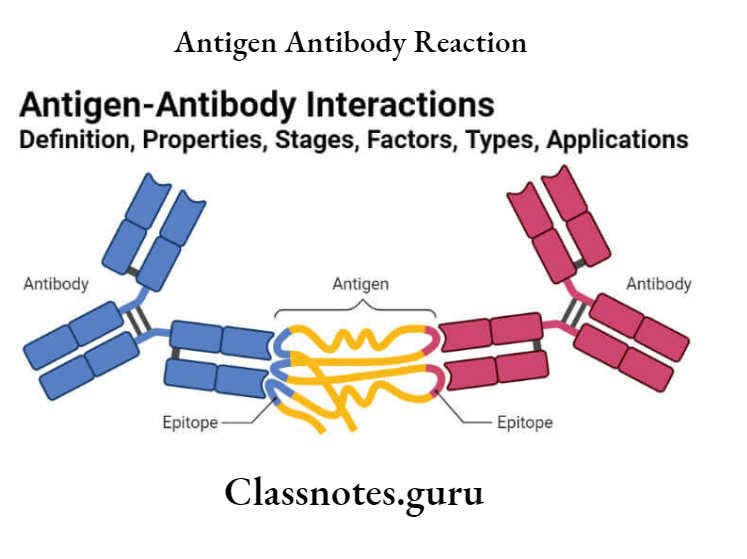
Immunodiffusion Test
Immunodiffusion tests are precipitation tests that occur in gel media.
Immunodiffusion Test Types:
1. Single Diffusion In One Dimension.
Single Diffusion In One Dimension Steps:
- Mix antibodies in agar gel in a test tube
- Pour antigen over it.
Single Diffusion In One Dimension Result:
- Antigen diffuses downward.
- A line of precipitation is formed.
Short note on antigen-antibody interaction
Double Diffusion In One Dimension
Double Diffusion In One Dimension Steps:
- Mix antibodies in agar gel in a test tube.
- Place a column of plain agar over it.
- Pour antigen over the plain agar.
Double Diffusion In One Dimension Result:
- Antigen and antibodies move towards each other
- A precipitation band is formed.
Single Diffusion In One Dimension
Single Diffusion In One Dimension Steps:
- Mix antibodies in agar gel on a slide.
- Cut wells on the surface of the gel.
- Add antigens to these wells.
Single Diffusion In One Dimension Results:
- Antigen diffuses radially,
- Ring-shaped bands of precipitation are formed.
Double Diffusion In Two Dimensions
Double Diffusion In Two Dimensions Steps:
- Place agar gel on a slide.
- Cut wells over it.
- Fill antibodies in the central well and antigens in other wells.
Double Diffusion In Two dimensions Results:
- Lines of precipitate formed between two identical adjacent antigens fuse.
Immunoelectrophoresis
Immunoelectrophoresis Steps:
- Combines electrophoresis and immunodiffusion.
- Semisolid agar is layered on a slide,
- Cut wells over it and fill it with antigen
- Electrophoresis of the antigen is carried out for 1 hour,
- Cut a rectangular through in the agar and fill it with antibodies.
- Allow diffusion for 18 – 24 hours.
Immunoelectrophoresis Results:
- Precipitation lines develop with each separated antigen.
Electroimmunodiffusion
- Electroimmunodiffusion is a combination of electrophoresis and diffusion.
- Electroimmunodiffusion includes.
- Counter immunoelectrophoresis.
- Rocket electrophoresis.

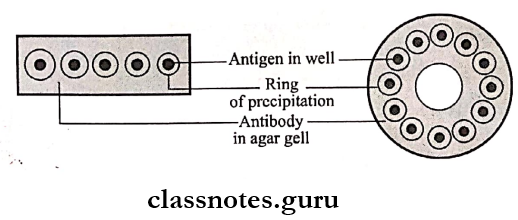

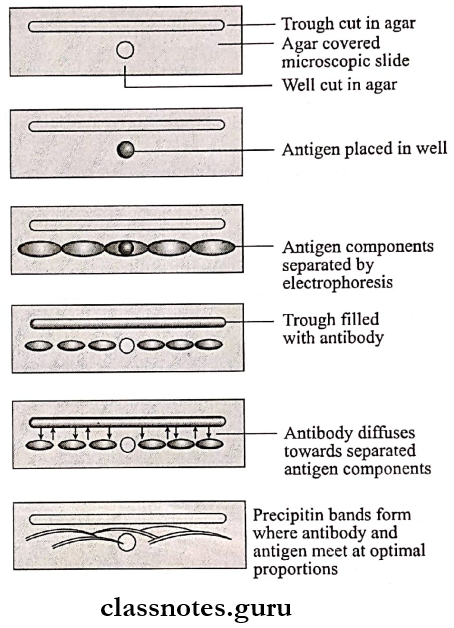
Applications of antigen-antibody complex in lab tests
Agglutination
Agglutination Definition:
- Agglutination is an antigen-antibody reaction in which a particular antigen combines with its antibody in the presence of electrolytes at an optimal temperature and pH
- Agglutination results in clump formation.
Agglutination Properties
- Occurs with a particulate antigen.
- Agglutination is more sensitive.
- Agglutination takes place better with IgM antibodies.
Agglutination Principle
- When antigen and antibody are present in optimal proportions, lattice formation occurs.
- This results in agglutination.
Diagnostic uses of antigen-antibody reaction
Agglutination Types
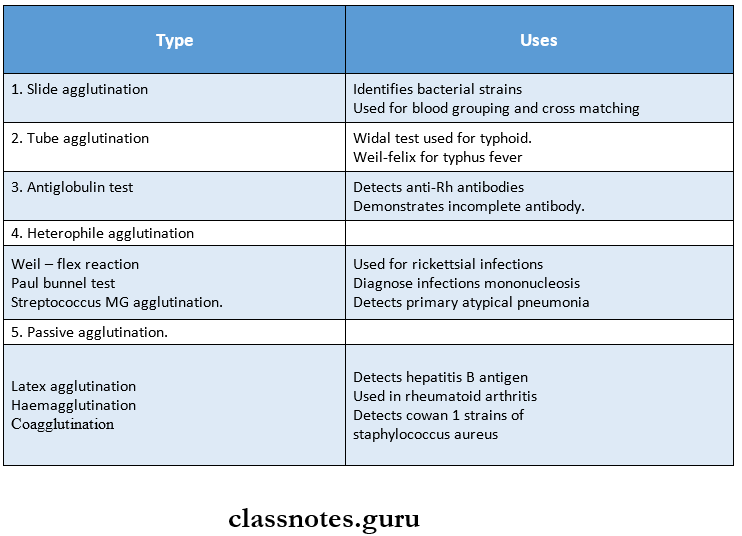
Immunofluorescence
Immunofluorescence

The dyes used are:

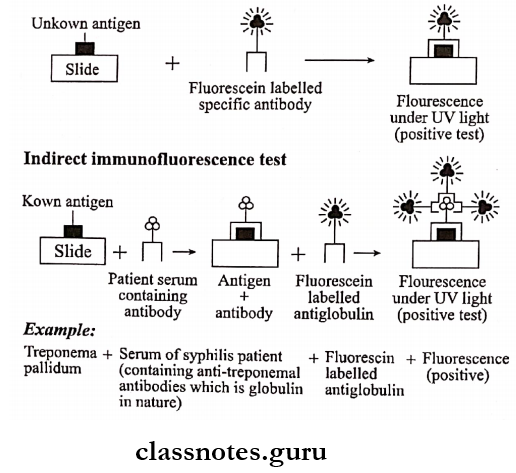
ELISA test
ELISA is an abbreviated form of Enzyme-Linked ImmunoSorbent Assay.
- ELISA test is widely used.
- ELISA test is simple and sensitive.
- The test can be done in polystyrene tubes or polyvinyl microlitre plates.
ELISA test Types:
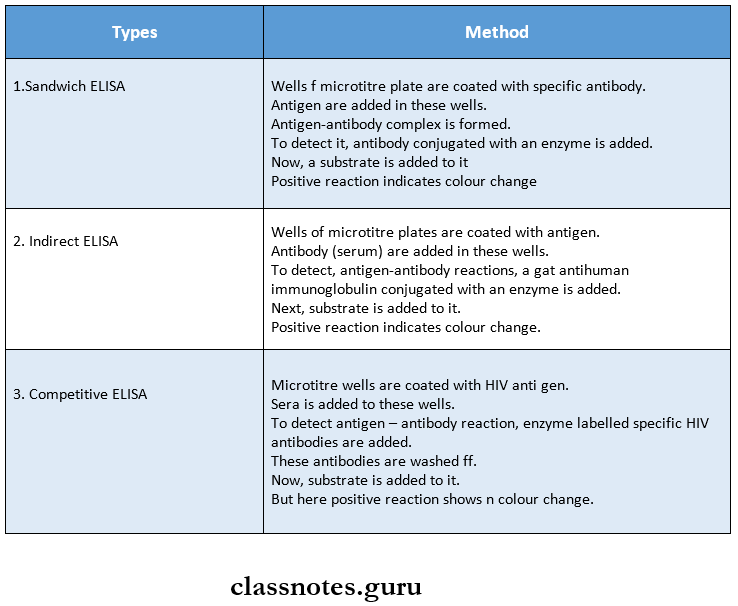

Antigen-Antibody Reaction
Question 1. Define precipitation and flocculation.
Answer:
Precipitation Definition
- When a soluble antigen reacts with its antibody in the presence of electrolytes at an optimal temperature and pH, the antigen-antibody complex forms an insoluble precipitate.
- This process is called precipitation.
Flocculation Definition
- When a particulate antigen reacts with its antibody in the presence of electrolytes at an optimal temperature and pH, the antigen-antibody reaction shows visible clumps of particles.
- This process is called flocculation.
Question 2. Zone of equivalence.
Answer:
Zone Of Equivalence
- When antigen and antibody are present in optimal or equivalent proportion, a large lattice is formed.
- This is results in precipitation.
- This zone where precipitation occurs in called the zone of equivalence.
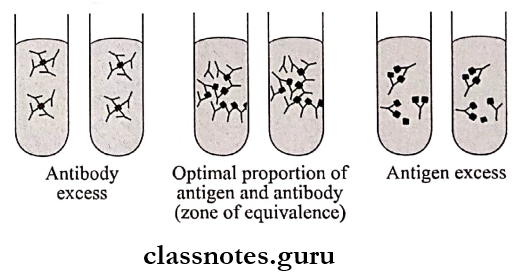
Question 3. Types of electro immunodiffusion.
Answer:
Types Of Electro Immunodiffusion

Coombs Test
The Coombs test was devised by Coombs, Mourant, and Race in 1945.
Coombs Test Method:
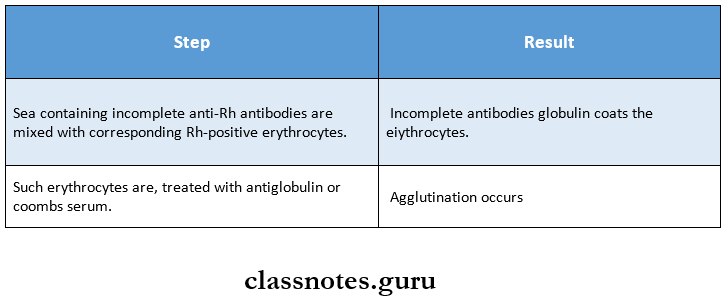
Coombs Test Types
- Direct Coombs test – in-vivo test
- Indirect Coombs test – in-vitro test.
Coombs Test Uses
- Detect anti – Rh antibodies.
- Demonstrates incomplete antibody.

Question 5. Coaggiutination.
Answer:
Coaggiutination
- Coaggiutination is a type of passive agglutination test.
- Coaggiutination is based on the presence of protein A on Cown I strains of staphylococcus aureus.
- Specific IgG is coated on these bacteria.
- IgG has two portions.
- Fc portion – Binds to protein A
- Fab terminal – remains free.
- When the corresponding antigen is mixed with it, the Fab terminal binds to it.
- This results in agglutination.
Coaggiutination Uses
- Detects bacterial antigens in blood, urine, and CSF.
- Detects N.gonorrhoea, strep pyrogens, and H. influenzae antigens.

Complement fixation test
Complement Fixation Test Principle:
The antigen-antibody complexes are able to fix complement.
Complement Fixation Test Method:
An indicator system consisting of sheep erythrocytes coated with an amboceptor is used.
Complete fixation is detected by this system.

Short note on antigen-antibody interaction
Complement Fixation Test Result
- Lysis of erythrocytes – indicates nagative reaction.
- No lysis of erythrocytes – indicates positive reaction.
Question 7. Define the Agglutination test with two examples.
Answer:
Agglutination Test Definition
- Agglutination Test is an antigen-antibody reaction in which a particulate antigen combines with its antibody in the presence of electrolytes at an optimal temperature and pH
- Agglutination Test results in clump formation
Agglutination Test Examples
- Weil – flex reaction – used for rickettsial infections
- Paul Bunnel test – used for diagnosis of infectious mononucleosis

